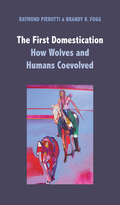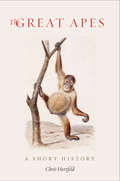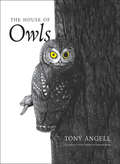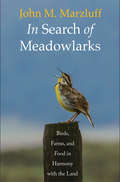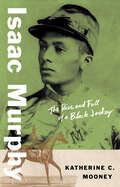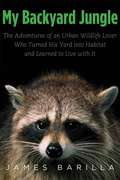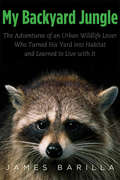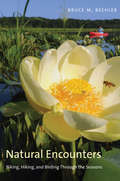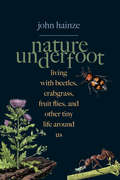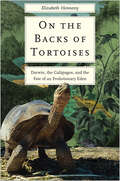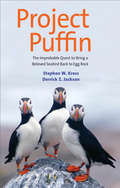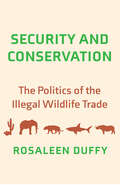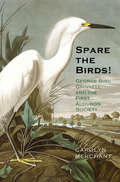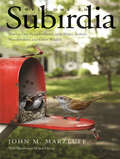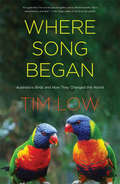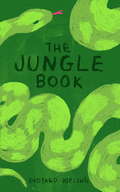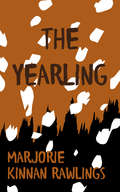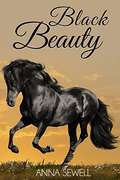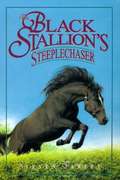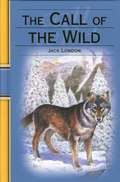- Table View
- List View
The First Domestication: How Wolves and Humans Coevolved
by Raymond Pierotti Brandy R. FoggA riveting look at how dog and humans became best friends, and the first history of dog domestication to include insights from indigenous peoples In this fascinating book, Raymond Pierotti and Brandy Fogg change the narrative about how wolves became dogs and in turn, humanity’s best friend. Rather than describe how people mastered and tamed an aggressive, dangerous species, the authors describe coevolution and mutualism. Wolves, particularly ones shunned by their packs, most likely initiated the relationship with Paleolithic humans, forming bonds built on mutually recognized skills and emotional capacity. This interdisciplinary study draws on sources from evolutionary biology as well as tribal and indigenous histories to produce an intelligent, insightful, and often unexpected story of cooperative hunting, wolves protecting camps, and wolf-human companionship. This fascinating assessment is a must-read for anyone interested in human evolution, ecology, animal behavior, anthropology, and the history of canine domestication.
The Great Apes: A Short History
by Chris HerzfeldA unique, beautifully illustrated exploration of our fascination with our closest primate relatives, and the development of primatology as a discipline This insightful work is a compact but wide-ranging survey of humankind’s relationship to the great apes (chimpanzees, bonobos, gorillas, orangutans), from antiquity to the present. Replete with fascinating historical details and anecdotes, it traces twists and turns in our construction of primate knowledge over five hundred years. Chris Herzfeld outlines the development of primatology and its key players and events, including well-known long-term field studies, notably the pioneering work by women such as Jane Goodall, Dian Fossey, and Biruté Galdikas. Herzfeld seeks to heighten our understanding of great apes and the many ways they are like us. The reader will encounter apes living in human families, painting apes, apes who use American Sign Language, and chimpanzees who travelled in space. A philosopher and historian specializing in primatology, Herzfeld offers thought-provoking insights about our perceptions of apes, as well as the boundary between “human” and “ape” and what it means to be either.
The House of Owls
by Mr. Tony AngellFor a quarter of a century, Tony Angell and his family shared the remarkable experience of closely observing pairs of western screech owls that occupied a nesting box outside the window of their forest home. The journals in which the author recorded his observations, and the captivating drawings he created, form the heart of this compelling book—a personal account of an artist-naturalist’s life with owls. Angell’s extensive illustrations show owls engaged in what owls do—hunting, courting, raising families, and exercising their inquisitive natures—and reveal his immeasurable respect for their secret lives and daunting challenges. Angell discusses the unique characteristics that distinguish owls from other bird species and provides a fascinating overview of the impact owls have had on human culture and thought. He also offers detailed scientific descriptions of the nineteen species of owls found in North America, as well as their close relatives elsewhere. Always emphasizing the interaction of humans and owls, the author affirms by his own example the power of these birds both to beguile and to inspire.
In Search of Meadowlarks: Birds, Farms, and Food in Harmony with the Land
by John M. MarzluffAn ornithologist’s personal look at farming practices that finds practical solutions for sustainable food production compatible with bird and wildlife conservation With predictions of a human population of more than nine billion by the middle of this century and eleven billion by 2100, we stand at a crossroads in our agricultural evolution. In this clear and engaging yet scientifically rigorous book, wildlife biologist John M. Marzluff takes a personal approach to sustainable agriculture. He travels to farms and ranches across North and Central America, including a Nebraska corn and soybean farm, California vineyards, cattle ranches in Montana, and small sustainable farms in Costa Rica, to understand the unique challenges and solutions to sustainable food production. Agriculture and wildlife can coexist, he argues, if farmers are justly rewarded for conservation; if future technological advancements increase food production and reduce food waste; and if consumers cut back on meat consumption. Beginning with a look backwards at our evolutionary history and concluding with practical solutions for change that will benefit farmers and ranchers, Marzluff provides an accessible and insightful study for the ecologically minded citizen, farmer, rancher, or conservationist.
Isaac Murphy: The Rise and Fall of a Black Jockey (Black Lives)
by Katherine C. MooneyThe rise and fall of one of America’s first Black sports celebrities Isaac Murphy, born enslaved in 1861, still reigns as one of the greatest jockeys in American history. Black jockeys like Murphy were at the top of the most popular sport in America at the end of the nineteenth century. They were internationally famous, the first African American superstar athletes—and with wins in three Kentucky Derbies and countless other prestigious races, Murphy was the greatest of them all. At the same time, he lived through the seismic events of Emancipation and Reconstruction and formative conflicts over freedom and equality in the United States. And inevitably he was drawn into those conflicts, with devastating consequences. Katherine C. Mooney uncovers the history of Murphy’s troubled life, his death in 1896 at age thirty-five, and his afterlife. In recounting Murphy’s personal story, she also tells two of the great stories of change in nineteenth-century America: the debates over what a multiracial democracy might look like and the battles over who was to hold power in an economy that increasingly resembled the corporate, wealth-polarized world we know today.
My Backyard Jungle: The Adventures of an Urban Wildlife Lover Who Turned His Yard into Habitat and Learned to Live with It
by James BarillaFor James Barilla and his family, the dream of transforming their Columbia, South Carolina, backyard into a haven for wildlife evoked images of kids catching grasshoppers by day and fireflies at night, of digging up potatoes and picking strawberries. When they signed up with the National Wildlife Federation to certify their yard as a wildlife habitat, it felt like pushing back, in however small a way, against the tide of bad news about vanishing species, changing climate, dying coral reefs. Then the animals started to arrive, and Barilla soon discovered the complexities (and possible mayhem) of merging human with animal habitats. What are the limits of coexistence, he wondered? To find out, Barilla set out across continents to explore cities where populations of bears, monkeys, marmosets, and honeybees live alongside human residents. My Backyard Jungle brings these unique stories together, making Barilla’s yard the centerpiece of a meditation on possibilities for coexistence with animals in an increasingly urban world. Not since Gerald Durrell penned My Family and Other Animals have readers encountered a naturalist with such a gift for storytelling and such an open heart toward all things wild.
My Backyard Jungle: The Adventures of an Urban Wildlife Lover Who Turned His Yard into Habitat and Learned to Live with It
by James BarillaFor James Barilla and his family, the dream of transforming their Columbia, South Carolina, backyard into a haven for wildlife evoked images of kids catching grasshoppers by day and fireflies at night, of digging up potatoes and picking strawberries. When they signed up with the National Wildlife Federation to certify their yard as a wildlife habitat, it felt like pushing back, in however small a way, against the tide of bad news about vanishing species, changing climate, dying coral reefs. Then the animals started to arrive, and Barilla soon discovered the complexities (and possible mayhem) of merging human with animal habitats. What are the limits of coexistence, he wondered? To find out, Barilla set out across continents to explore cities where populations of bears, monkeys, marmosets, and honeybees live alongside human residents. My Backyard Jungle brings these unique stories together, making Barilla’s yard the centerpiece of a meditation on possibilities for coexistence with animals in an increasingly urban world. Not since Gerald Durrell penned My Family and Other Animals have readers encountered a naturalist with such a gift for storytelling and such an open heart toward all things wild.
My Backyard Jungle: The Adventures of an Urban Wildlife Lover Who Turned His Yard into Habitat and Learned to Live with It
by James BarillaFor James Barilla and his family, the dream of transforming their Columbia, South Carolina, backyard into a haven for wildlife evoked images of kids catching grasshoppers by day and fireflies at night, of digging up potatoes and picking strawberries. When they signed up with the National Wildlife Federation to certify their yard as a wildlife habitat, it felt like pushing back, in however small a way, against the tide of bad news about vanishing species, changing climate, dying coral reefs. Then the animals started to arrive, and Barilla soon discovered the complexities (and possible mayhem) of merging human with animal habitats. What are the limits of coexistence, he wondered? To find out, Barilla set out across continents to explore cities where populations of bears, monkeys, marmosets, and honeybees live alongside human residents. My Backyard Jungle brings these unique stories together, making Barilla’s yard the centerpiece of a meditation on possibilities for coexistence with animals in an increasingly urban world. Not since Gerald Durrell penned My Family and Other Animals have readers encountered a naturalist with such a gift for storytelling and such an open heart toward all things wild.
Natural Encounters: Biking, Hiking, and Birding Through the Seasons
by Bruce M. BeehlerA twelve-month excursion through nature’s seasons as recounted by a lifetime naturalist In this “personal encyclopedia of nature’s seasons,” lifetime naturalist Bruce Beehler reflects on his three decades of encountering nature in Washington, D.C. The author takes the reader on a year-long journey through the seasons as he describes the wildlife seen and special natural places savored in his travels up and down the Potomac River and other localities in the eastern and central United States. Some of these experiences are as familiar as observing ducks on the National Mall in Washington, D.C., or as unexpected as collecting fifty-million-year-old fossils on a Potomac beach. Beyond our nation’s capital, Beehler describes trips to nature’s most beautiful green spaces up and down the East Coast that, he says, should be on every nature lover’s bucket list. Combining diary entries, riffs on natural subjects, field trips, photographs, and beautiful half-tone wash drawings, this book shows how many outdoor adventures are out there waiting in one’s own backyard. The author inspires the reader to embrace nature to achieve a more peaceful existence.
Nature Underfoot: Living with Beetles, Crabgrass, Fruit Flies, and Other Tiny Life Around Us
by John HainzeAn informed and heartfelt tribute to commonly unappreciated plants, insects, and other tiny creatures that reconsiders humanity’s relationship to nature Fruit flies, silverfish, dandelions, and crabgrass are the bane of many people and the target of numerous chemical and physical eradication efforts. In this compelling reassessment of the relationship between humans and the natural world, John Hainze—an entomologist and former pesticide developer—considers the fascinating and bizarre history of how these so-called invasive or unwanted pests and weeds have coevolved with humanity and highlights the benefits of a greater respect and moral consideration toward these organisms. With deep insight into the lives of the underappreciated and often reviled creatures that surround us, Hainze’s accessible and engaging natural history draws on ethics, religion, and philosophy as he passionately argues that creepy crawlies and unwanted plants deserve both empathy and accommodation as partners dwelling with us on earth.
On the Backs of Tortoises: Darwin, the Galapagos, and the Fate of an Evolutionary Eden
by Elizabeth HennessyAn insightful exploration of the iconic Galápagos tortoises, and how their fate is inextricably linked to our own in a rapidly changing world The Galápagos archipelago is often viewed as a last foothold of pristine nature. For sixty years, conservationists have worked to restore this evolutionary Eden after centuries of exploitation at the hands of pirates, whalers, and island settlers. This book tells the story of the islands’ namesakes—the giant tortoises—as coveted food sources, objects of natural history, and famous icons of conservation and tourism. By doing so, it brings into stark relief the paradoxical, and impossible, goal of conserving species by trying to restore a past state of prehistoric evolution. The tortoises, Elizabeth Hennessy demonstrates, are not prehistoric, but rather microcosms whose stories show how deeply human and nonhuman life are entangled. In a world where evolution is thoroughly shaped by global history, Hennessy puts forward a vision for conservation based on reckoning with the past, rather than trying to erase it.
Project Puffin: The Improbable Quest to Bring a Beloved Seabird Back to Egg Rock (A\national Audubon Society Book)
by Stephen W. Kress Derrick Z. JacksonProject Puffin is the inspiringstory of how a beloved seabird was restored to long-abandoned nesting colonies off the Maine coast. As a young ornithology instructor at the Hog Island Audubon Camp, Dr. Stephen W. Kress learned that puffins had nested on nearby islands until extirpated by hunters in the late 1800s. To right this environmental wrong, he resolved to bring puffins back to one such island—Eastern Egg Rock. Yet bringing the plan to reality meant convincing skeptics, finding resources, and inventing restoration methods at a time when many believed in “letting nature take its course.” Today, Project Puffin has restored more than 1,000 puffin pairs to three Maine islands. But even more exciting, techniques developed during the project have helped to restore rare and endangered seabirds worldwide. Further, reestablished puffins now serve as a window into the effects of climate change. The success of Dr. Kress's project offers hope that people can restore lost wildlife populations and the habitats that support them. The need for such inspiration has never been greater.
Security and Conservation: The Politics of the Illegal Wildlife Trade
by Rosaleen DuffyAn exploration of the scale, practical reality, and future implications of the growing integration of biodiversity conservation with global security concerns “There are few keener observers of international biodiversity conservation than Rosaleen Duffy. With a ferocity of purpose, she investigates the tenuous connection and nuances among illegal wildlife trade, terrorism threats, and national security.”—Steven R. Brechin, Rutgers University, New Brunswick Debates regarding environmental security risks have generally focused on climate change and geopolitical water conflicts. Biodiversity conservation, however, is increasingly identified as a critical contributor to national and global security. The illegal wildlife trade is often articulated as a driver of biodiversity losses, and as a source of finance for organized crime networks, armed groups, and even terrorist networks. Conservationists, international organizations, and national governments have raised concerns about “convergence” of wildlife trafficking with other serious offenses, including theft, fraud, corruption, drugs and human trafficking, counterfeiting, firearms smuggling, and money laundering. In Security and Conservation, Rosaleen Duffy examines the scale, practical reality, and future implications of the growing integration of biodiversity conservation with global security concerns. Duffy takes a political ecology approach to develop a deeper understanding of how and why wildlife conservation turned toward security‑oriented approaches to tackle the illegal wildlife trade.
Spare the Birds!: George Bird Grinnell and the First Audubon Society
by Carolyn MerchantIn 1887, a year after founding the Audubon Society, explorer and conservationist George Bird Grinnell launched Audubon Magazine. The magazine constituted one of the first efforts to preserve bird species decimated by the women’s hat trade, hunting, and loss of habitat. Within two years, however, for practical reasons, Grinnell dissolved both the magazine and the society. Remarkably, Grinnell’s mission was soon revived by women and men who believed in it, and the work continues today. In this, the only comprehensive history of the first Audubon Society (1886–1889), Carolyn Merchant presents the exceptional story of George Bird Grinnell and his writings and legacy. The book features Grinnell’s biographies of ornithologists John James Audubon and Alexander Wilson and his editorials and descriptions of Audubon’s bird paintings. This primary documentation combined with Carolyn Merchant’s insightful analysis casts new light on Grinnell, the origins of the first Audubon Society, and the conservation of avifauna.
Welcome to Subirdia: Sharing Our Neighborhoods with Wrens, Robins, Woodpeckers, and Other Wildlife
by John M. MarzluffWelcome to Subirdia presents a surprising discovery: the suburbs of many large cities support incredible biological diversity. Populations and communities of a great variety of birds, as well as other creatures, are adapting to the conditions of our increasingly developed world. In this fascinating and optimistic book, John Marzluff reveals how our own actions affect the birds and animals that live in our cities and towns, and he provides ten specific strategies everyone can use to make human environments friendlier for our natural neighbors. Over many years of research and fieldwork, Marzluff and student assistants have closely followed the lives of thousands of tagged birds seeking food, mates, and shelter in cities and surrounding areas. From tiny Pacific wrens to grand pileated woodpeckers, diverse species now compatibly share human surroundings. By practicing careful stewardship with the biological riches in our cities and towns, Marzluff explains, we can foster a new relationship between humans and other living creatures—one that honors and enhances our mutual destiny.
Where Song Began: Australia's Birds and How They Changed the World
by Tim LowAn authoritative and entertaining exploration of Australia’s distinctive birds and their unheralded role in global evolution Renowned for its gallery of unusual mammals, Australia is also a land of extraordinary birds. But unlike the mammals, the birds of Australia flew beyond the continent’s boundaries and around the globe many millions of years ago. This eye-opening book tells the dynamic but little-known story of how Australia provided the world with songbirds and parrots, among other bird groups, why Australian birds wield surprising ecological power, how Australia became a major evolutionary center, and why scientific biases have hindered recognition of these discoveries. From violent, swooping magpies to tool-making cockatoos, Australia’s birds are strikingly different from birds of other lands—often more intelligent and aggressive, often larger and longer-lived. Tim Low, a renowned biologist with a rare storytelling gift, here presents the amazing evolutionary history of Australia’s birds. The story of the birds, it turns out, is inseparable from the story of the continent itself and also the people who inhabit it.
Wild Visions: Wilderness as Image and Idea
by Ben A Minteer Mark Klett Stephen J. PyneA stunning combination of landscape photography and thematic essays exploring how the concept of wilderness has evolved over time Our ideas of wilderness have evolved dramatically over the past one hundred and fifty years, from a view of wild country as an inviolable “place apart” to one that exists only within the matrix of human activity. This shift in understanding has provoked complicated questions about the importance of the wild in American environmentalism, as well as new aesthetic expectations as we reframe the wilderness as (to some degree) a human creation.Wild Visions is distinctive in its union of landscape photography and environmental thought, a merging of short, thematic essays with a striking visual narrative. Often, the wild is viewed in binary terms: either revered as sacred and ecologically pure or dismissed as spoiled by human activities. This book portrays wilderness instead as an evolving gamut of understandings, a collage of views and ideas that is still in process.
The Wingsnappers: Lessons from an Exuberant Tropical Bird
by Barney A. SchlingerBirds, hormones, and extraordinary behavior: The story of the tiny but mighty golden-collared manakin of Panama This book is the story of a remarkable bird, the golden-collared manakin (Manacus vitellinus) of Panama. Males of this species perform one of the most elaborate, physically complex, and noisy courtship displays of any animal on the planet. Barney A. Schlinger delves into the specialized neurons, muscles, bones, and hormonal systems underlying the manakin’s unique courtship behavior, creating a rich life-history account that integrates field observations and evolutionary biology with behavioral ecology, anatomy, physiology, biomechanics, and general ornithology. The personal lives of investigators and the natural history of the Panamanian rainforest provide context for this account of the bird's fascinating behavior. Schlinger clearly and approachably explains basic concepts in disciplines such as avian anatomy, endocrinology, sexual differentiation, and the neurobiology of song and aeroacoustics, offering readers a window into the biology of this exuberant bird.
The Jungle Book
by Rudyard KiplingSince its publication in 1894, Rudyard Kipling’s beloved masterpiece The Jungle Book has been celebrated by generations of readers. Composed of seven tales, each one accompanied by a poem, The Jungle Book introduces a lush, colorful world full of adventure and danger. The first three tales include some of the most charming and unforgettable characters in literature—the man-cub Mowgli, the black panther Bagheera, the wise brown bear Baloo, and the ruthless tiger Shere Khan. The other four tales each tell the story of a different animal, such as the travels of the white seal Kotick; the battle between the courageous mongoose Rikki-Tikki-Tavi and the deadly cobra Nag; Toomai and the elephant dance; and the camp animals of the queen’s guard.
The Yearling (Illustrated Classics Series)
by Marjorie RawlingsAn American, bestselling classic and a Pulitzer Prize–winning novel, The Yearling epitomizes the love between a child and a pet. When young Jody Baxter adopts an orphaned fawn he calls Flag, he makes it a part of his family—and his best friend. But life in the Florida backwoods isn’t easy, and as his family fights off wolves, bears, alligators, and economic ruin in farming, Jody and his family realize that the maturing Flag is endangering their survival, and Jody is forced to face the reality of the situation and to make the toughest decision he’ll ever have. Penguin Random House Canada is proud to bring you classic works of literature in e-book form, with the highest quality production values. Find more today and rediscover books you never knew you loved.
كليلة و دمنة
by مجهولقال علي بن الشاه الفارسي: كان السبب الذي من أجله وضع بيدبا الفيلسوف لدبشليم ملك الهند كتاب "كليلة ودمنة" أن الإسكندر ذا القرنين الرومي لمَّا فرغ من أمر الملوك الذين كانوا بناحية المغرب سار يريد ملوك المشرق من الفرس وغيرهم. فلم يزل يحارب مَنْ نازعه ويواقع مَنْ واقعه ويسالم مَنْ وادعه من ملوك الفرس وهم الطبقة الأولى حتى ظهر عليهم وقهر مَنْ ناواه، وتغلَّب على مَنْ حاربه فتفرَّقوا طرائق وتمزَّقوا حزائق؛ فتوجه بالجنود نحو بلاد الصين فبدأ في طريقه بملك الهند ليدعوه إلى طاعته والدخول في ملته وولايته. وكان على الهند في ذلك الزَّمان ملك ذو سطوة وبأس وقوة ومراس يقال له فور؛ فلمَّا بلغه إقبال ذي القرنين نحوه تأهب لمحاربته واستعدَّ لمجاذبته وضمَّ إليه أطرافه وجدَّ في التألب عليه وجمع له العدَّة في أسرع مدَّة، من الفيلة المعدَّة للحروب والسباع المضراة بالوثوب، مع الخيول المسرجة، والسيوف القواطع، والحراب اللوامع. فلمَّا قرب ذو القرنين من فور الهندي وبلغه ما قد أعدَّ له من الخيل التي كأنها قطع الليل، مما لم يلقه بمثله أحد من الملوك الذين كانوا في الأقاليم، تخوَّف ذو القرنين من تقصير يقع به إن عجَّل المبارزة. وكان ذو القرنين رجلاً ذا حيل ومكايد مع حسن تدبير وتجربة؛ فرأى إعمال الحيلة والتمهُّل، واحتفر خندقًا على عسكره وأقام بمكانه لاستنباط الحيلة والتدبير لأمره وكيف ينبغي له أن يقدم على الإيقاع به، فاستدعى المنجمين وأمرهم بالاختيار ليوم موافق تكون له فيه سعادة لمحاربة ملك الهند والنصرة عليه؛ فاشتغلوا بذلك. وكان ذو القرنين لا يمرُّ بمدينة إلاَّ أخذ الصُنَّاع المشهورين من صُنَّاعها بالحذق من كل صنف؛ فنتجت له همته ودلته فطنته أن يتقدَّم إلى الصناع الذين معه أن يصنعوا خيلاً من نحاس مجوفة عليها تماثيل من الرجال على بكر تجري، إذا دفعت مرَّت سراعًا، وأمر إذا فرغوا منها أن تُحْشَى أجوافها بالنفط والكبريت وتلبس وتقدَّم أمام الصف في القلب، ووقف ما يلتقي الجمعان تضرب فيها النيران، فإن الفيلة إذا لفت خراطيمها على الفرسان وهي حامية ولَّت هاربة، وأوعز إلى الصناع بالتشمير والانكماش والفراغ منها؛ فجدُّوا في ذلك وعجَّلوا وقرب أيضًا وقت اختيار المنجمين؛ فأعاد ذو القرنين رسله إلى فور بما يدعوه إليه من طاعته والإذعان لدولته؛ فأجاب جواب مُصرٍّعلى مخالفته مقيم على محاربته. فلمَّا رأى ذو القرنين عزيمته سار إليه بأهبته وقدَّم فور الفيلة أمامه، ودفعت الرجال تلك الخيل وتماثيل الفرسان، فأقبلت الفيلة نحوها ولفت خراطيمها عليها، فلمَّا أحسَّت بالحرارة ألقت مَنْ كان عليها وداستهم تحت أرجلها ومضت مهزومة هاربة لا تلوي على شيء ولا تمرُّ بأحد إلاَّ وطئته. وتقطع فور وجمعه وتبعهم أصحاب الإسكندر وأثخنوا فيهم الجراح، وصاح الإسكندر: يا ملك الهند ابرز إلينا وأبق على عدتك وعيالك ولا تحملهم على الفناء. فإنه ليس من المروءة أن يرمي الملك بعدته في المهالك المتلفة والمواضع المجحفة، بل يقيهم بماله ويدفع عنهم بنفسه. فابرز إلي ودع الجند فأينا قهر صاحبه فهو الأسعد. فلمَّا سمع فور من ذي القرنين ذلك الكلام دعته نفسه إلى ملاقاته؛ طمعًا فيه، وظن ذلك فرصة، فبرز إليه الإسكندر فتجاولا على ظهري فرسيهما ساعات من النهار ليس يلقى أحدهما من صاحبه فرصة ولم يزالا يتعاركان. فلمَّا أعيا الإسكندر أمره ولم يجد فرصة ولا حيلة أوقع ذو القرنين في عسكره صيحة عظيمة ارتجت لها الأرض والعساكر؛ فالتفت فور عندما سمع الزعقة وظنَّها مكيدة في عسكره، فعاجله ذو القرنين بضربة أمالته عن سرجه أتبعها بأخرى فوقع إلى الأرض. فلمَّا رأت الهنود ما نزل بهم وما صار إليه ملكهم حملواعلى الإسكندر فقاتلوه قتالاً أحبوا معه الموت، فوعدهم من نفسه الإحسان ومنحه الله أكتافهم فاستولى على بلادهم وملَّك عليهم رجلاً من ثقاته وأقام بالهند حتى استوسق له ما أرد من أمرهم واتفاق كلمتهم، ثم انصرف عن الهند وخلَّف ذلك الرجل عليهم ومضى متوجهًا نحو ما قصد له.
The Black Stallion's Steeplechaser
by Steven FarleySired by the champion Black Stallion, Black Storm is everything a race horse should be--strong and fast, brave and proud. But he is also very hard to handle, and his unruly nature makes him a misfit at Hopeful Farm. Young jockey Alec Ramsay continues to believe in the unpredictable colt, confident that Storm has it in his blood to become a champion steeplechaser. Unfortunately, Storm's trainer, Henry, has lost patience with the colt's violent mood swings and is threatening to sell the magnificent animal--at any price. Now Alec must convince Henry to allow him and Storm to enter one more race together. One more chance for the Black Stallion's Steeplechaser to prove himself a winner. And one last chance to save Hopeful Farm. . .
The Call of the Wild
by Jack LondonFirst published in 1903, The Call of the Wild is regarded as Jack London's masterpiece. Based on London's experiences as a gold prospector in the Canadian wilderness and his ideas about nature and the struggle for existence, The Call of the Wild is a tale about unbreakable spirit and the fight for survival in the frozen Alaskan Klondike.
Letters from the Hon David Humphreys, F R S to the Rt Hon Sir Joseph Banks: Containing Some Account of the Serpent of the Ocean, Frequently Seen in Gloucester Bay
by David HumphreysThis is a reproduction of a book published before 1923. This book may have occasional imperfections such as missing or blurred pages, poor pictures, errant marks, etc. that were either part of the original artifact, or were introduced by the scanning process. We believe this work is culturally important, and despite the imperfections, have elected to bring it back into print as part of our continuing commitment to the preservation of printed works worldwide. We appreciate your understanding of the imperfections in the preservation process, and hope you enjoy this valuable book.
